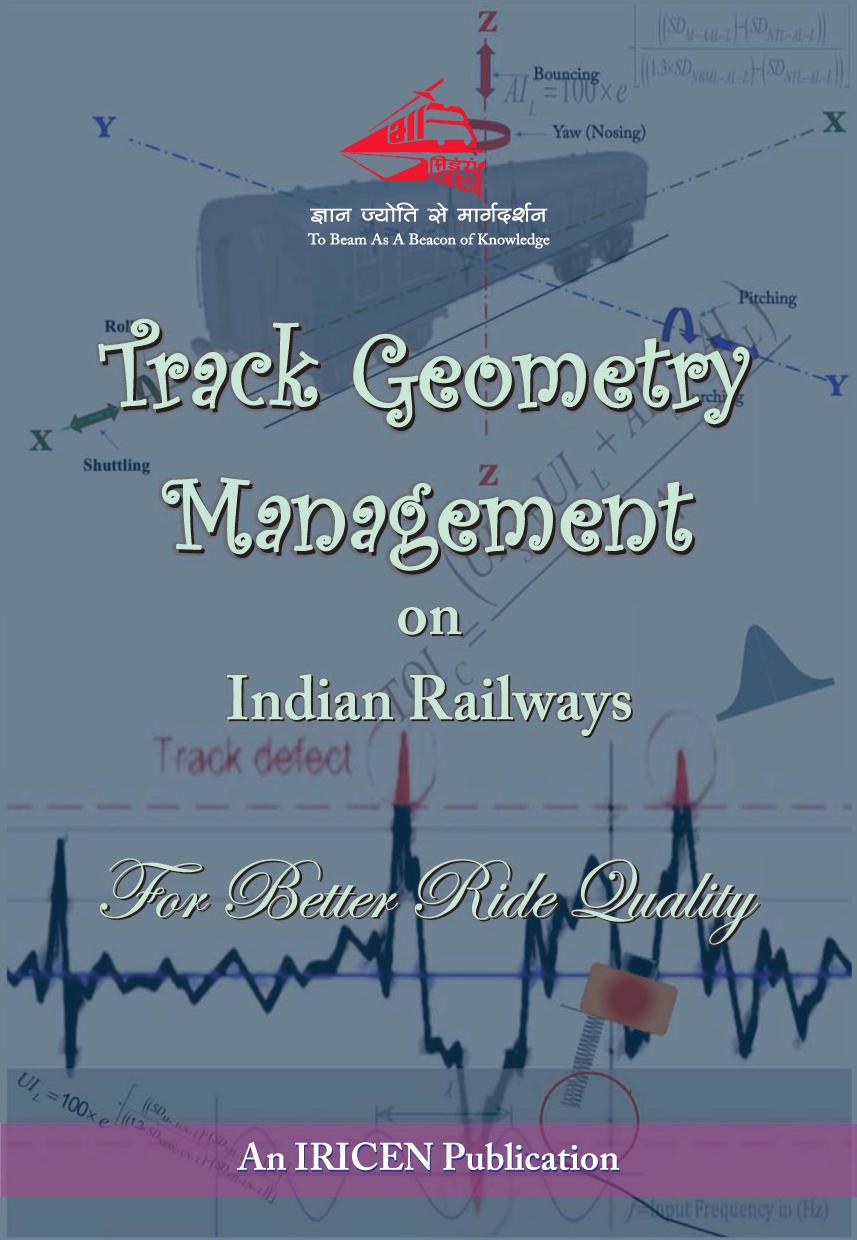Forward
The recent changes introduced by Indian Railways concerning track recording, analysis and monitoring has entirely altered landscape of track geometry management. Considering the speed policy framework on Indian Railways, various speed bands have been prescribed along with acceptable level of track geometry quality with respect to acceptable ride quality for each of the speed band.
This publication is an endeavor of IRICEN to spread the awareness about the new track geometry management regime on Indian Railway. I hope that it would be of immense help in developing understanding of the topic.
Preface
The mechanized monitoring of track geometry has come a long way since introduction of first mechanical TRC during early 60s, followed by Track Recording-cum Research Car in 70s, Microprocessor based TRCs in 80s and now the High Speed TRCs in use since last 10 years. The routes of Golden quadrilateral and diagonals have already been planned for increase in speeds upto 160 km/h and remaining routes are being planned for speeds upto 130 km/h. Furthermore the high speed corridor is also likely to be commissioned in foreseeable future indicating that the Indian Railways is on the threshold of railway speed explosion, calling for tighter management of Track Geometry.
With the recent changes in the IRPWM, the track geometry management on Indian Railways is now aligned with the latest world practices and follows similar principles as applicable on advanced railway systems and predominantly focused on the ride quality.
This publication has been drafted on the insistence and under guidance of Shri Ajay Goyal, Director, IRICEN as an initial appreciation of the various changes recently brought in IRPWM. It is highly likely that quite a few elements of the new mechanism might change in near future as this new system evolves and creases iron out.
The author is grateful to Shri R. P. Tiwari, Director(TM), RDSO who has rendered immense help in developing understanding and made available the various formats and a lot of contents. The author is also grateful to a large number of individuals with whom various discussions and interactions have taken place and included here in some form or the other.
Introduction
Railway Tracks: also known as “Railroad” is an inseparable, and vital sub-system in a rail based transportation system, which needs regular inspections to assess geometrical and structural conditions of the track components and assemblies for its ability to carry the loads and various forces exerted by the rolling stock running over it. The quantum of these loads and the forces depend not only on the design, construction and maintenance condition of the rolling stock but also on the speeds; at which these ply. These loads and forces would further increase or diminish in case of variations in any of the geometrical parameters of the track.
The Permanent Way (popularly called P.Way) personnel responsible for the maintenance of “Track”carryout regular periodic inspections to assess the structural and geometrical health of the track. The regular monitoring of the track condition enables planning and delivering of inputs, as
required, in time for maintenance of Track as well asits renewals. To satisfy the basic principles of track maintenance viz. safety, comfort and cost effectiveness; the optimized track maintenance strategy helps in reducing costs of maintenance by ensuring that maintenance inputs are applied to the identified locations, where these are necessarily required from ride quality considerations. The strategy being that to “Touch the Track only when required and where required”.
The variations in the geometrical parameters of the track could be either a result of deterioration under regular train operations or an indication of any other underlying issues relating to either condition of various track components or condition of ballast bed, sub-grade,sub-soil etc. individually or combination in varying proportions.
Inspection on foot, by trollies, by locomotive, or by rear vehicles enable the P. Way maintenance personnel to carry out realistic assessment of the track conditions and its performance. These inspections, though important, are mostly subjective and enable assessment based on individual’s and experience etc.
The objective assessment of track geometry and track components is possible by Track Recording Cars. The track performance in the form of accelerations generated due to variations in track geometry parameter(s) could be measured by accelerometers in various monitoring equipment.
The acceleration measurements can be used to give an indication of track geometry quality and to detect the local track geometry deviations, which have an influence on the dynamic behaviour of a vehicle. These measurements should be used in conjunction with the main parameter measurements described in the standard.
However, it must be kept in mind that the acceleration measurements are sensitive to the dynamic behaviour of the vehicle and other factors such as climatic conditions, actual position of the vehicle in the train and wheel rail interaction, which restrict liberal comparison under varying recording conditions.
Track Monitoring Equipment:
The following track recording equipment are in use on Indian Railways at present:
(a) Track Recording Car
(b) Oscillograph Car
(c) Oscillation Monitoring System
CONTENT
Introduction
Factors Affecting Vehicle Response
Vehicle Response and
Measurement of Oscillations
Resonance Frequency and Chords for Measurements
Measurement of Track Parameters
Data Analysis & Measure of
Track Quality
Tolerances
Deciphering TRC Reports
Maintenance Planning
